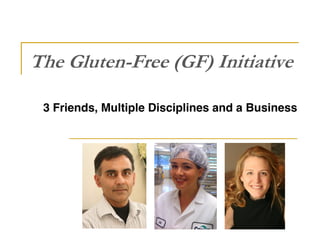Gluten Free AACC Int 2009
- 1. The Gluten-Free (GF) Initiative 3 Friends, Multiple Disciplines and a Business
- 2. Wheat Gluten
- 3. Patent Background Priority Date: This application claims the benefit of priority of U.S. Provisional Application Number 60/837,331 filed on August 11, 2006. Claim 1: A composition for making a gluten-free product, comprising a gluten-free gas-retaining polymer, and a gluten-free setting polymer. Example 2: Hydrocolloid Treatment Optimization of Example 2 resulted in 4 gluten-free bread prototypes.
- 4. Optimized Bread O verall L iking Product N O verall L iking Sara Lee White Classic 21 6.81a Whole Foods Gluten Free 24 6.04ab Cargill Gluten Free 32 7.09a Kinnikinnick White 25 5.28ab Sandwich Ener-G Tapioca Loaf - 26 3.19b Cargill Gluten Free and Sara Lee White Classic scored significantly Higher in Overall Liking than Ener-G Tapioca. -
- 5. Bread Texture and Shelf Life Bread Chewiness vs. Time 1200 Wonder Classic Cargill GF Good Source of Fiber Cargill GF Original 1000 Pepperidge Farm Jewish Rye 800 Bread Chewiness 600 400 200 0 0 2 4 6 8 10 12 Age of Cargill GF Bread (Days)
- 6. GF Breadmaking Rules vs. Conventional Made from a viscous batter that is high in water. Mixing hydrates hydrocolloids, modified starches and emulsifiers, which thicken and hold the batter together. Shorter proof times than normal because diffusion is faster in the batter and air cells are less stable. Emulsifiers increase the stability of air cells. The batter matrix retains air cells, but lacks strength and collapses if it contacts a solid surface. Upon heating, yeast and chemical leavening and in turn expanding air cells yield ovenspring, which must occur quickly before the batter sets. Film forming ingredients promote oven spring by improving batter strength and flexibility of the batter. The batter sets as starch gelatinizes and proteins denature. Set-ability is highly dependent on plasticizer (sugar, water, etc.) content. In the baked bread, hydrocolloids, starches and emulsifiers impart chewy and soft bread texture. Flavors are added to the batter to enhance final bread flavor. Flavors compensate for gluten and the flavors that result from reactions between gluten and sugars.
- 7. Safety Threshold Level for Gluten Maximum safe level of gluten for patients with celiac disease (CD) <0.002% (<20 ppm) The Gluten Test: R-Biopharm RIDASCREENÂŪ FAST Gliadin (ELISA kit) Minimum detection level of 10 ppm gluten Official AACC International Method?
- 8. CD Pharmaceutical Therapy in Development Inadvertent gluten exposure is a pain point for patients. Reduce gluten exposure in small intestine with oral therapy that acts in the stomach. Glutamine specific cysteine protease Proline specific prolyl endopeptidase HLA-DQ2 Inflammatory GI PQPQLPYPQ Â TG2 Gluten Proteases PQPELPYPQ Â T-cell PQQPFPQQP Â PQQPFPEQP Â Activation Oral Enzymes







